Galliformes – or wildfowl – are heavy-bodied ground-feeding birds that include familiar species, such as Turkey, Chicken and Pheasant. Hybridization is a common phenomenon is this bird group.
Alectoris
There are several species of Alectoris partridges, distributed across Eurasia and Africa (Watson, 1962). Some species live in sympatry and hybridize naturally, while other species have been introduced in the range of other for hunting purposes and also hybridize. However, domesticated birds seem to have a lower survival rate (Duarte & Vargas, 2004). Four species pairs have been studied. The Sardinian Partridge (A. barbara) does not appear to interbreed with other species (Scandura et al., 2010), although markers to detect hybridization have been developed (Barbanera et al., 2011b).

Red-legged Partridge (Alectoris rufa)
The Red-legged Partridge (A. rufa) and the Rock Partridge (A. graeca) overlap in the southern Alps. The hybrid zone cline is shorter than expected which could point to selection against hybrids (Barilani et al., 2007a; Randi & Bernard-Laurent, 1999). Rock Partidges have also been introduced outside of their natural range into the Iberian peninsula where they also hybridize with native Red-legged Partridges (Negro, Torres & Godoy, 2001). The call characterists of both species and their hybrids have been studied (Ceugniet et al., 1999) and playback experiments reveal similar reactions to conspecific and hybrid calls, however, hybrids responded stronger to hybrid calls (Ceugniet & Aubin, 2001).
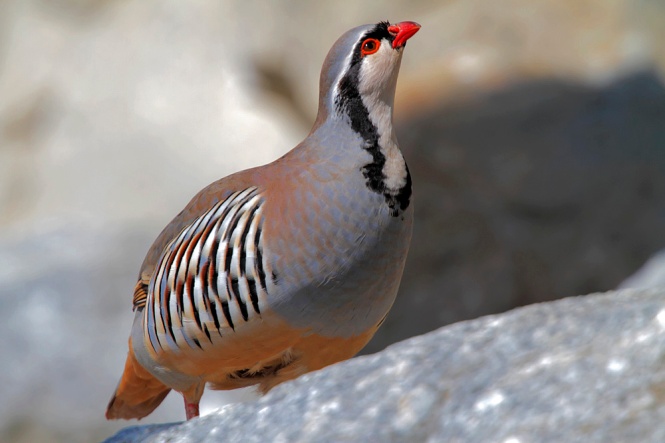
Rock Partridge (Alectoris graeca)
The Red-legged Partridge also interbreeds with the introduced Chukar Partridge (A. chukar) (Barbanera et al., 2010); introgression has been detected in Italy (Baratti et al., 2005; Barbanera et al., 2007; Barbanera et al., 2009; Barbanera et al., 2005; Negri et al., 2013), Iberia (Blanco-Aguiar et al., 2008; Martinez-Fresno, Henriques-Gil & Arana, 2008; Sevane et al., 2011; Tejedor et al., 2007), France (Barbanera et al., 2009) and the United Kingdom (Barbanera et al., 2015). The population of Red-legged Partridges on Corsica seems to be non-introgressed (Barbanera et al., 2011a). Genomic analyses confirmed these patterns, but indicated that introgression is quite limited across the range of the Red-legged Partridge (Forcina et al., 2021).
Studies on the fitness of these hybrids showed that hybrids have bigger clutch sizes but lower hatching success and survival rates compared to pure individuals (Casas et al., 2012) and that male hybrids are smaller while female ones have a better condition but lower carotenoid level (Casas et al., 2013).
The Chukar Partrigde also hybridizes with other species, such as the Rock Partrigde in Greece (Barilani et al., 2007b) and Italy/France (Barilani et al., 2007a) and the Przevalski’s Partridge (A. magna) in China (Chen et al., 1998; Huang et al., 2009; Yang & Liu, 2009).
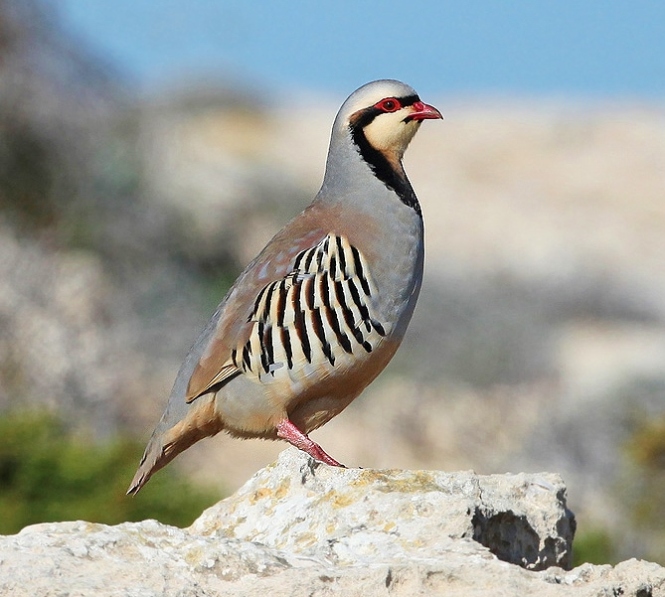
Chukar Partridge (Alectoris chukar)
Chrysolophus
On a nearly 900-year-old Chinese painting, a hybrid between Golden Pheasant (C. pictus) and Lady Amherst’s Pheasant (C. amherstiae) is depicted (Peng et al., 2016).

The painting of a hybird pheasant (from Peng et al., 2016)
Coturnix
The Common Quail (C. coturnix) and the Japanese Quail (C. japonica) hybridize naturally in Russia, but the main concern is the release of domesticated Quail, which often carry “Japanese genes” (Sanchez-Donoso et al., 2012), in European populations of Common Quail (Amaral et al., 2007; Barilani et al., 2005; Chazara et al., 2010). Despite the release of these birds, the population size of Common Quail does not seem to be affected (Puigcerver, Sarda-Palomera & Rodriguez-Teijeiro, 2012; Puigcerver, Vinyoles & Rodriguez-Teijeiro, 2007). Hybrids do not differ in fertility or hatching success (Chang et al., 2009; Deregnaucourt, Guyomarc’h & Aebischer, 2002), but do show lower survival rates and suffer more from nest predation (Puigcerver et al., 2014), which could explain the limited effect of restocking. Interbreeding could however impact the migratory behavior of Common Quail. Experimental studies have shown that hybrids lose their tendency for migration (Deregnaucourt, Guyomarc’h & Spano, 2005; Deregnaucourt, Gyomarc’h & Belhamra, 2005). Restocked individuals were also not associated with migratory and wintering quails at northern latitudes (Sanchez-Donoso et al., 2014). The calls of both quail species and their hybrids have been heavily studied (Collins & Goldsmith, 1998; Deregnaucourt, 2010; Deregnaucourt, Guyomarc’h & Richard, 2001). One study found that Japanese Quails respond equally to conspecific, heterospecific and hybrid calls, which could lead to hybridization (Deregnaucourt & Guyomarc’h, 2003).
The egg production of hybrids between Japanese Quail and Brown Quail (C. ypsilophora) have also been investigated in an experimental setting (Vali, 2007).
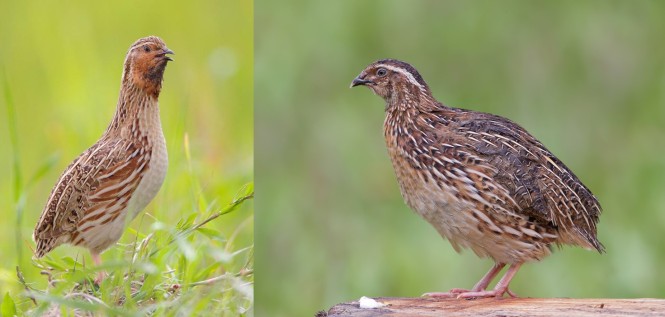
Common Quail (Coturnix coturnix) and Japanese Quail (C. japonica)
Gallus
This genus, known as Junglefowl, contains four species: Sri Lanka Junglefowl (G. lafayetti), Grey Junglefowl (G. sonneratii), Green Junglefowl (G. varius), and Red Junglefowl (G. gallus). The latter species is probably the ancestor of the domestic chicken (Brisbin & Peterson, 2007; van Grouw, & Dekkers, 2020), although there has been gene flow from the other species (Lawal et al., 2020). For example, the gene that provides domestic chickens with their yellow skin was probably acquired through hybridization with Grey Junglefowl (Eriksson et al., 2008). Domestic chickens are regularly crossbred, as exemplified by a genetic study in Africa (Leroy et al., 2012). A phylogenetic study revealed that hybridization has also occurred between Grey Junglefowl and Red Junglefowl, and between Grey Junglefowl and Sri Lanka Junglefowl (Nishibori et al., 2005). The former cross has been described in captvity (Morejohn, 1968). On the Hawaiian island Kauai, escaped feral chickens are probably the result of hybridization between Red Junglefowl from Polynesia and recently escaped domestic chickens from Europe (Gering et al., 2015). Similarly, in Singapore, there has been introgression between wild Red Junglefowl and feral chickens (Wu et al., 2020).
Domestic chickens have also been crossed experimentally with Helmeted Guineafowl (Numida meleagris) (Leroy, Barbier & Auzanneau, 1908; Leroy, Barbier & Auzanneau, 1967) and Pheasant (Phasianus colchicus) (Castillo et al., 2012; Castillo et al., 2010).
Several Chinese indigenous chicken breeds have been genetically “polluted” by commercial broilers (Zhang et al., 2019; Nie et al., 2019).
The Ecuadorian Creole chicken probably originated from Asian birds that were brought to Chile in pre-Columbian times. Later, the introduction of Spanish breeds by the conquistadors in the 15th century led to several admixture events (Toalombo Vargas et al., 2019).

Grey Junglefowl (Gallus sonneratii)
Lagopus
One experimental study described the effects of increasing daylength om Willow Grouse (L. lagopus) and Red Grouse (L. l. scoticus) and their hybrids (Sharp & Moss, 1981). Introgression between Willow Grouse and Rock Ptarmigan (L. muta) occurs in Central Sweden (Quintela, Thulin & Hoglund, 2010).

Red Grouse (Lagopus lagopus scoticus) and Willow Grouse (L. lagopus)
Lophura
The Gallopheasants are classified into ten species (Randi et al., 2001). The extinct Imperial Pheasant (L. imperialis) turned out to be a occasional hybrid between Silver Pheasant (L. nycthemera) and Edwards’s Pheasant (L. edwardsi), one specimen was probably even a hybrid between Silver Pheasant and Vietnamese Pheasant (L. hatinhensis) (Hennache et al., 2003). A phylogeographic study uncovered hybridization between Silver Pheasant and Kalij Pheasant (L. leucomelanos) in China (Dong et al., 2013).
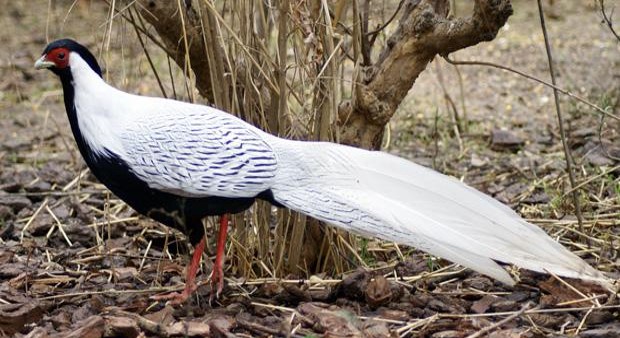
Silver Pheasant (Lophura nycthemera)
Meleagris
Wild Turkeys (M. gallopavo) hybridize extensively with introduced subspecies in Texas (Latch et al., 2006).
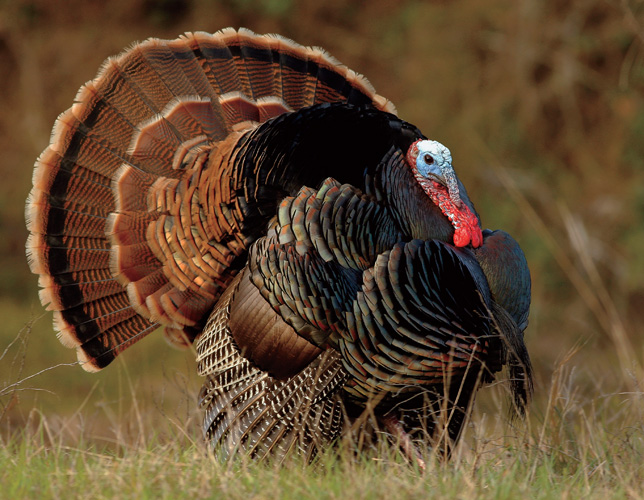
Wild Turkey (Meleagris gallopavo)
Numida
The Helmeted Guineafowl (N. meleagris) has been crossed with other galliform species, such as the domestic chicken (Gallus gallus) (Beddard, 1899; Guyer, 1909; Kalla, Danladi & Dass, 2008; Leroy et al., 1908; Leroy et al., 1967; Morton, 1847; Vilaró Díaz, 1897). The latter hybrid is still used in other research areas (Liu & Zhu, 2008; Mathis & McDougald, 1987). There is also hybridization between wild and domesticated Guineafowl (Walker et al., 2004).
Genetic analyses of a putative hybrid between Helmeted Guineafowl and Brazilian Guan (Penelope superciliaris) (Ruschi & Amadon, 1959) revealed that it was actually a hybrid between Helmeted Guineafowl and Chicken (Alfieri et al., 2023).

Helmeted Guineafowl (Numida meleagris)
Odontophoridae
The New World Quails is an American bird family which comprises several genera. Hybrids within (Bailey, 1928; Banks & Walker, 1964; Cink, 1975; Hubbard, 1966) and between genera (McCabe, 1954; Peck, 1911; Sutton, 1963) have been documented, and summarized by Johnsgard (1970), who also conducted an experimental study on hybridization among Odontophoridae (Johnsgard, 1971).
Hybridization between Califoria Quail (Callipepla californica) and Gambel’s Quail (C. gambelii) has been documented in the past (Henshaw, 1885). The hybrid zone between these species was studied extensively by Jennifer Gee (Gee, 2003a). Using microsatellites (Gee, Calkins & Petren, 2003), she showed that the hybrid zone is located on a cline, and that introgression does not occur beyond this zone (Gee, 2004). Species discrimination is possible in captivity, but in nature breeding is random (Gee, 2003b). Social network analyses suggest that birds pair up based on body mass and monomorphic (i.e. the same in both sexes) plumage traits (Zonana et al., 2019) and mate randomly with regard to genetic ancestry (Zonana et al., 2020). Acoustical signals might be important in this context (Gee, 2005; Gee, Tomaszycki & Adkins-Regan, 2009).
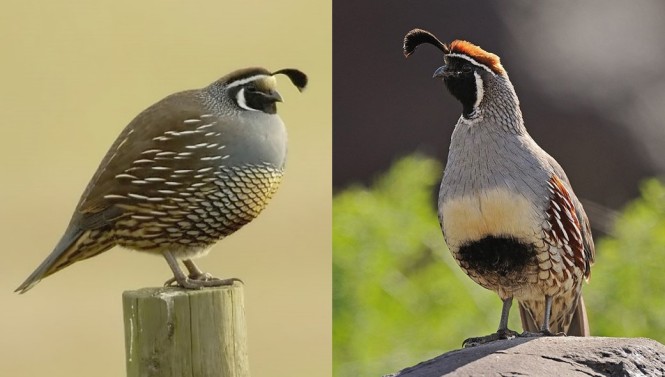
California Quail (Callipepla californica) and Gambel’s Quail (C. gambelii)
Pauxi
The Alagoas Curassow (P. mitu) is extinct in the wild. To conserve this species it has been crossed with Razor-billed Curassow (P. tuberosa) (Silveira, Olmos & Long, 2013; Sousa et al., 2013; Wajntal, Pereira & Grau, 2010).
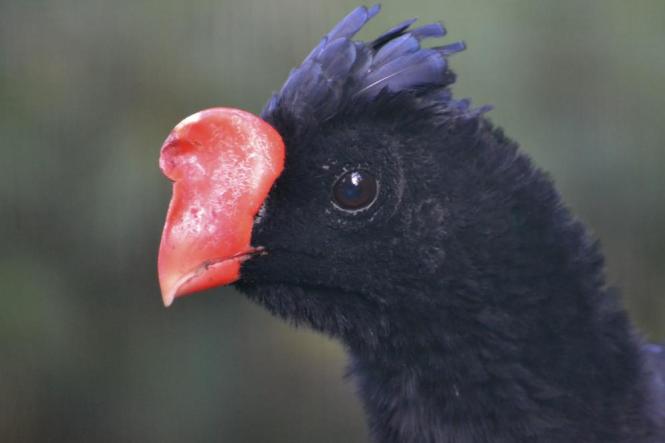
Razor-billed Curassow (Pauxi tuberosa)
Phasianus
The is only one species of Pheasant (P. colchicus), which is subdivided into numerous subspecies that interbreed (Zhang et al., 2014). Hybrids between Sichuan Pheasant (P. c. strauchi) and Ring-necked Pheasant (P. c. torquatus) showed increased survival which resulted in a higher number of chicks per season (Niewoonder, Prince & Luukkonen, 1998). Hybrid pheasants were also more likely to establish themselves, a phenomenon dubbed “catapult effect” (Drake, 2006).
Pheasants have also hybridized with domestic chickens (Castillo et al., 2010; Castillo et al., 2012) and there is a record of a wild hybrid involving Dusky Grouse (Dendragapus obscurus) (Anthony, 1899).

Common Pheasant (Phasianus colchicus)
Perdix
The effect of released Grey Partridges (P. perdix) on native populations has been investigated in Denmark (Andersen & Kahlert, 2012) and Finland (Liukkonen, Kvist & Mykra, 2012). In both cases, introduced birds were significantly different from wild ones.

Grey Partridge (Perdix perdix)
Tetrao
The behavior (Porkert, Solheim & Flor, 1997) and sperm characeteristcs (Ciereszko et al., 2009) of hybrids between Black Grouse (T. tetrix) and Capercaillie (T. urogallus) have been described. Relatively unsuccessful attempts to cross Capercaillie with chicks have been conducted (Skjervold & Mjelstad, 1992).

Black Grouse (Tetrao tetrix)
Tetraogallus
Several genetic studies suggested hybridization between the Tibetan Snowcock (Tetraogallus tibetanus) and the Himalayan Snowcock (T. himalayensis) in Asia (An et al., 2020; Ding et al., 2020)

Himalayan Snowcock © Subharanjan Sen | Oriental Bird Club Image Database
Tympanuchus
This genus of Prairie Chickens comprises three species that all hybridize, for instance Greater (T. cupido) Prairie Chicken hybridizes with Lesser Prairie Chicken (T. pallidicinctus) (Bain & Farley, 2002) and Sharp-tailed Grouse (T. phasianellus) (Lumsden, 2005a; Lumsden, 2005b). Introgression between these species has been confirmed by genetic analyses (Galla & Johnson, 2015). In addition, intergeneric hybrids have been reported:
- Sharp-tailed Grouse and Greater Sage Grouse (Centrocercus urophasianus) (Aldridge, Oyler-McCance & Brigham, 2001; Eng, 1971)
- Sharp-tailed Grouse and Dusky Grouse (Dendragapus obscurus) (Brooks, 1907; Lincoln, 1950; O’Donnell, 2015)

Greater Prairie Chicken (Tympanychus cupido)
References
Aldridge, C. L., Oyler-McCance, S. J. & Brigham, R. M. (2001). Occurrence of Greater Sage-Grouse x Sharp-tailed Grouse hybrids in Alberta. Condor 103, 657-660.
Alfieri, J. M., Johnson, T., Linderholm, A., Blackmon, H., & Athrey, G. N. (2023). Genomic investigation refutes record of most diverged avian hybrid. Ecology and Evolution, 13(1): e9689.
Amaral, A. J., Silva, A. B., Grosso, A. R., Chikhi, L., Bastos-Silveira, C. & Dias, D. (2007). Detection of hybridization and species identification in domesticated and wild quails using genetic markers. Folia Zoologica 56, 285-300.
An, B., Zhang, L., Wang, Y., & Song, S. (2020). Comparative phylogeography of two sister species of snowcock: impacts of species-specific altitude preference and life history. Avian Research, 11(1), 1.
Andersen, L. W. & Kahlert, J. (2012). Genetic indications of translocated and stocked grey partridges (Perdix perdix): does the indigenous Danish grey partridge still exist? Biological Journal of the Linnean Society 105, 694-710.
Anthony, A. (1899). Hybrid grouse. The Auk 16, 180-181.
Bailey, V. (1928). A Hybrid Scaled× Gambel’s Quail from New Mexico. The Auk, 210-210.
Bain, M. R. & Farley, G. H. (2002). Display by apparent hybrid Prairie-Chickens in a zone of geographic overlap. Condor 104, 683-687.
Banks, R. C. & Walker, L. W. (1964). A Hybrid Scaled× Douglas Quail. The Wilson Bulletin, 76, 378-380.
Baratti, M., Ammannati, M., Magnelli, C. & Dessì‐Fulgheri, F. (2005). Introgression of chukar genes into a reintroduced red‐legged partridge (Alectoris rufa) population in central Italy. Animal Genetics 36, 29-35.
Barbanera, F., Forcina, G., Guerrini, M. & Dini, F. (2011a). Molecular phylogeny and diversity of the Corsican red-legged partridge: hybridization and management issues. Journal of Zoology 285, 56-65.
Barbanera, F., Guerrini, M., Bertoncini, F., Cappelli, F., Muzzeddu, M. & Dini, F. (2011b). Sequenced RAPD markers to detect hybridization in the barbary partridge (Alectoris barbara, Phasianidae). Molecular Ecology Resources 11, 180-184.
Barbanera, F., Guerrini, M., Hadjigerou, P., Panayides, P., Sokos, C., Wilkinson, P., Khan, A. A., Khan, B. Y., Cappelli, F. & Dini, F. (2007). Genetic insight into Mediterranean chukar (Alectoris chukar, Galliformes) populations inferred from mitochondrial DNA and RAPD markers. Genetica 131, 287-298.
Barbanera, F., Guerrini, M., Khan, A. A., Panayides, P., Hadjigerou, P., Sokos, C., Gombobaatar, S., Samadi, S., Khan, B. Y., Tofanelli, S., Paoli, G. & Dini, F. (2009). Human-mediated introgression of exotic chukar (Alectoris chukar, Galliformes) genes from East Asia into native Mediterranean partridges. Biological Invasions 11, 333-348.
Barbanera, F., Negro, J. J., Di Giuseppe, G., Bertoncini, F., Cappelli, F. & Dini, F. (2005). Analysis of the genetic structure of red-legged partridge (Alectoris rufa, Galliformes) populations by means of mitochondrial DNA and RAPD markers: a study from central Italy. Biological Conservation 122, 275-287.
Barbanera, F., Pergams, O. R. W., Guerrini, M., Forcina, G., Panayides, P. & Dini, F. (2010). Genetic consequences of intensive management in game birds. Biological Conservation 143, 1259-1268.
Barbanera, F., Forcina, G., Cappello, A., Guerrini, M., van Grouw, H. & Aebischer, N. J. (2015). Introductions over introductions: the genomic adulteration of an early genetically valuable alien species in the United Kingdom. Biological Invasions 17, 409-422.
Barilani, M., Bernard-Laurent, A., Mucci, N., Tabarroni, C., Kark, S., Garrido, J. A. P. & Randi, E. (2007a). Hybridisation with introduced chukars (Alectoris chukar) threatens the gene pool integrity of native rock (A-graeca) and red-legged (A-rufa) partridge populations. Biological Conservation 137, 57-69.
Barilani, M., Deregnaucourt, S., Gallego, S., Galli, L., Mucci, N., Piombo, R., Puigcerver, M., Rimondi, S., Rodriguez-Teijeiro, J. D., Spano, S. & Randi, E. (2005). Detecting hybridization in wild (Coturnix c. coturnix) and domesticated (Coturnix c. japonica) quail populations. Biological Conservation 126, 445-455.
Barilani, M., Sfougaris, A., Giannakopoulos, A., Mucci, N., Tabarroni, C. & Randi, E. (2007b). Detecting introgressive hybridisation in rock partridge populations (Alectoris graeca) in Greece through Bayesian admixture analyses of multilocus genotypes. Conservation Genetics 8, 343-354.
Beddard, F. E. (1899). XXVI.—On a Hybrid between a male Guinea‐fowl and a female Domestic Fowl, with some Observations on the Osteology of the Numididæ. Ibis 41, 333-344.
Blanco-Aguiar, J. A., Gonzalez-Jara, P., Ferrero, M. E., Sanchez-Barbudo, I., Virgos, E., Villafuerte, R. & Davila, J. A. (2008). Assessment of game restocking contributions to anthropogenic hybridization: the case of the Iberian red-legged partridge. Animal Conservation 11, 535-545.
Brisbin, I. L. & Peterson, A. T. (2007). Playing chicken with red junglefowl: identifying phenotypic markers of genetic purity in Gallus gallus. Animal Conservation 10, 429-435.
Brooks, A. (1907). A hybrid grouse, Richardson’s+ Sharp-tail. The Auk 24, 167-169.
Casas, F., Mougeot, F., Ferrero, M. E., Sanchez-Barbudo, I., Davila, J. A. & Vinuela, J. (2013). Phenotypic differences in body size, body condition and circulating carotenoids between hybrid and “pure” red-legged partridges (Alectoris rufa) in the wild. Journal of Ornithology 154, 803-811.
Casas, F., Mougeot, F., Sanchez-Barbudo, I., Davila, J. A. & Vinuela, J. (2012). Fitness consequences of anthropogenic hybridization in wild red-legged partridge (Alectoris rufa, Phasianidae) populations. Biological Invasions 14, 295-305.
Castillo, A., Marzoni, M., Pirone, A. & Romboli, I. (2012). Histological observations in testes of hybrids of Gallus gallus x Phasianuns colchicus. Avian Biology Research 5, 21-30.
Castillo, A., Romboli, I., Marzoni, M. & Stanyon, R. (2010). Karyotype of chicken-pheasant hybrids. Avian Biology Research 3, 17-21.
Ceugniet, M. & Aubin, T. (2001). The rally call recognition in males of two hybridizing partridge species, red-legged (Alectoris rufa) and rock (A-graeca) partridges. Behavioural Processes 55, 1-12.
Ceugniet, M., Aubin, T., Bernard-Laurent, A. & Soyez, D. (1999). Vocal signatures of the rally call of red-legged and rock partridges and of their hybrids. Comptes Rendus De L Academie Des Sciences Serie Iii-Sciences De La Vie-Life Sciences 322, 887-895.
Chang, G. B., Liu, X. P., Chang, H., Chen, G. H., Zhao, W. M., Ji, D. J., Chen, R., Qin, Y. R., Shi, X. K. & Hu, G. S. (2009). Behavior differentiation between wild Japanese quail, domestic quail, and their first filial generation. Poultry Science 88, 1137-1142.
Chazara, O., Minvielle, F., Roux, D., Bed’hom, B., Feve, K., Coville, J. L., Kayang, B. B., Lumineau, S., Vignal, A., Boutin, J. M. & Rognon, X. (2010). Evidence for introgressive hybridization of wild common quail (Coturnix coturnix) by domesticated Japanese quail (Coturnix japonica) in France. Conservation Genetics 11, 1051-1062.
Chen, Q., Chang, C., Liu, N., Randi, E. & Lucchini, V. (1998). Mitochondrial DNA introgression between two parapatric species of Alectoris. Dong wu xue bao.[Acta zoologica Sinica] 45, 456-463.
Ciereszko, A., Kowalczyk, A., Lukaszewicz, E., Krzywinski, A., Kobus, A. & Dietrich, G. J. (2009). Sperm characteristics of male hybrid from a cross between male Black Grouse Tetrao tetrix and female Capercaillie T. urogallus. Ornis Fennica 86, 149-152.
Cink, C. L. (1975). Egg fertility and hatchability in Colinus quail and their hybrids. The Auk 92, 803-805.
Collins, S. A. & Goldsmith, A. R. (1998). Individual and species differences in quail calls (Coturnix c. japonica, c. c. coturnix and a hybrid). Ethology 104, 977-990.
Deregnaucourt, S. (2010). Interspecific Hybridization as a Tool to Understand Vocal Divergence: The Example of Crowing in Quail (Genus Coturnix). Plos One 5.
Deregnaucourt, S. & Guyomarc’h, J. C. (2003). Mating call discrimination in female European (Coturnix c. coturnix) and Japanese quail (Coturnix c. japonica). Ethology 109, 107-119.
Deregnaucourt, S., Guyomarc’h, J. C. & Aebischer, N. J. (2002). Hybridization between European Quail Coturnix coturnix and Japanese Quail Coturnix japonica. Ardea 90, 15-21.
Deregnaucourt, S., Guyomarc’h, J. C. & Richard, V. (2001). Classification of hybrid crows in quail using artificial neural networks. Behavioural Processes 56, 103-112.
Deregnaucourt, S., Guyomarc’h, J. C. & Spano, S. (2005). Behavioural evidence of hybridization (Japanese x European) in domestic quail released as game birds. Applied Animal Behaviour Science 94, 303-318.
Deregnaucourt, S., Gyomarc’h, J. C. & Belhamra, M. (2005). Comparison of migratory tendency in European Quail Coturnix c. coturnix, domestic Japanese Quail Coturnix c. japonica and their hybrids. Ibis 147, 25-36.
Ding, L., Liao, J., & Liu, N. (2020). The uplift of the Qinghai–Tibet Plateau and glacial oscillations triggered the diversification of Tetraogallus (Galliformes, Phasianidae). Ecology and Evolution, 10(3), 1722-1736.
Dong, L., Heckel, G., Liang, W. & Zhang, Y. Y. (2013). Phylogeography of Silver Pheasant (Lophura nycthemera L.) across China: aggregate effects of refugia, introgression and riverine barriers. Molecular Ecology 22, 3376-3390.
Drake, J. M. (2006). Heterosis, the catapult effect and establishment success of a colonizing bird. Biology Letters 2, 304-307.
Duarte, J. & Vargas, J. (2004). Field interbreeding of released farm-reared red-legged partridges (Alectoris rufa) with wild ones. Game and Wildlife Science 21, 55-61.
Eng, R. L. (1971). Two Hybrid Sage Grouse× Sharp-Tailed Grouse from Central Montana. Condor, 491-493.
Eriksson, J., Larson, G., Gunnarsson, U., Bed’hom, B., Tixier-Boichard, M., Stromstedt, L., Wright, D., Jungerius, A., Vereijken, A., Randi, E., Jensen, P. & Andersson, L. (2008). Identification of the Yellow skin gene reveals a hybrid origin of the domestic chicken. Plos Genetics 4.
Forcina, G., Tang, Q., Cros, E., Guerrini, M., Rheindt, F. E., & Barbanera, F. (2021). Genome-wide markers redeem the lost identity of a heavily managed gamebird. Proceedings of the Royal Society B, 288(1947), 20210285.
Galla, S. J. & Johnson, J. A. (2015). Differential introgression and effective size of marker type influence phylogenetic inference of a recently divergent avian group (Phasianidae: Tympanuchus). Mol Phylogenet Evol 84, 1-13.
Gee, J. M. (2003a). The causes and consequences of hybridization in California and Gambel’s Quail. Integrative and Comparative Biology 43, 998-998.
Gee, J. M. (2003b). How a hybrid zone is maintained: Behavioral mechanisms of interbreeding between California and Gambel’s Quail (Callipepla californica and C-gambelii). Evolution 57, 2407-2415.
Gee, J. M. (2004). Gene flow across a climatic barrier between hybridizing avian species, California and Gambel’s quail (Callipepla californica and C-gambelii). Evolution 58, 1108-1121.
Gee, J. M. (2005). No species barrier by call in an avian hybrid zone between California and Gambel’s quail (Callipepla californica and C-gambelii). Biological Journal of the Linnean Society 86, 253-264.
Gee, J. M., Calkins, J. D. & Petren, K. (2003). Isolation and characterization of microsatellite loci in hybridizing California and Gambel’s quail (Callipepla californica and C-gambelii). Molecular Ecology Notes 3, 35-36.
Gee, J. M., Tomaszycki, M. L. & Adkins-Regan, E. (2009). Sex-Dependent Species Discrimination in Auditory Forebrain of Naturally Hybridizing Birds. Brain Behavior and Evolution 74, 258-267.
Gering, E., Johnsson, M., Willis, P., Getty, T. & Wright, D. (2015). Mixed ancestry and admixture in Kauai’s feral chickens: invasion of domestic genes into ancient Red Junglefowl reservoirs. Molecular Ecology 24, 2112-2124.
Guyer, M. F. (1909). Atavism in guinea‐chicken hybrids. Journal of Experimental Zoology 7, 723-745.
Hennache, A., Rasmussen, P., Lucchini, V., Rimondi, S. & Randi, E. (2003). Hybrid origin of the imperial pheasant Lophura imperialis (Delacour and Jabouille, 1924) demonstrated by morphology, hybrid experiments, and DNA analyses. Biological Journal of the Linnean Society 80, 573-600.
Henshaw, H. (1885). Hybrid Quail (Lophortyx gambeli x L. californicus). The Auk 2, 247-249.
Huang, Z. H., Yang, Z. S., Zhang, J. & Liu, N. F. (2009). Introgressive hybridization and population genetic diversity between rusty-necklaced partridge and chukar partridge in northwestern China. Belgian Journal of Zoology 139, 15-21.
Hubbard, J. P. (1966). A possible back-cross hybrid involving Scaled and Gambel’s Quail. The Auk, 136-137.
Johnsgard, P. A. (1970). A summary of intergeneric New World quail hybrids, and a new intergeneric hybrid combination. Condor, 85-88.
Johnsgard, P. A. (1971). Experimental hybridization of the New World quail (Odontophorinae). The Auk, 264-275.
Kalla, D., Danladi, F. & Dass, U. (2008). Chicken guinea fowl hybrid produced under natural mating. Nigerian Veterinary Journal 29, 59-61.
Latch, E. K., Harveson, L. A., King, J. S., Hobson, M. D. & Rhodes, O. E. (2006). Assessing hybridization in wildlife populations using molecular markers: A case study in wild turkeys. Journal of Wildlife Management 70, 485-492.
Lawal, R. A., et al. 2020). The wild species genome ancestry of domestic chickens. BMC Biology, 18(1), 1-18.
Leroy, G., Kayang, B. B., Youssao, I. A. K., Yapi-Gnaore, C. V., Osei-Amponsah, R., Loukou, N. E., Fotsa, J. C., Benabdeljelil, K., Bed’hom, B., Tixier-Boichard, M. & Rognon, X. (2012). Gene diversity, agroecological structure and introgression patterns among village chicken populations across North, West and Central Africa. Bmc Genetics 13.
Leroy, P., Barbier, Y. & Auzanneau, C. (1908). L’Hybride de Gallus domestieus and Numida meleagris. Histologie du testicule—eomparaison avec le coq et le male Pintade. Arch. Aunt. Hist. Embr 51, 401-406.
Leroy, P., Barbier, Y. & Auzanneau, C. (1967). [The male Gallus domesticus X female Numida meleagris hybrid. Histology of the testicle. Comparison with thedomestic cock and the guinea-cock]. Archives d’anatomie, d’histologie et d’embryologie normales et experimentales 51, 399-406.
Lincoln, F. C. (1950). A ring-necked pheasant x prairie chicken hybrid. The Wilson Bulletin, 210-212.
Liu, Y. & Zhu, Q. (2008). No Evidence for Paternal Leakage of mtDNA in Inter-Specific Hybrids of the Domestic Fowls (Gallus gallus) and Guinea Fowls (Numida meleagris). Research Journal of Animal Sciences 2, 53-56.
Liukkonen, T., Kvist, L. & Mykra, S. (2012). Microsatellite markers show distinctiveness of released and wild grey partridges in Finland. Animal Biodiversity and Conservation 35, 419-428.
Lumsden, H. (2005a). ” Prairie Grouse”, Tympanuchus cupido× phasianellus, Hybridization on Manitoulin Island, Ontario. The Canadian Field-Naturalist 119, 507-514.
Lumsden, H. G. (2005b). Plumage and Internal Morphology of the” Prairie Grouse”, Tympanuchus cupido× phasianellus, of Manitoulin Island, Ontario. The Canadian Field-Naturalist 119, 515-524.
Martinez-Fresno, M., Henriques-Gil, N. & Arana, P. (2008). Mitochondrial DNA sequence variability in red-legged partridge, Alectoris rufa, Spanish populations and the origins of genetic contamination from A-chukar. Conservation Genetics 9, 1223-1231.
Mathis, G. F. & McDougald, L. R. (1987). Evaluation of interspecific hybrids of the chicken, guinea fowl, and Japanese quail for innate resistance to coccidia. Avian diseases, 740-745.
McCabe, R. A. (1954). Hybridization between the Bob-white and Scaled Quail. The Auk, 293-297.
Morejohn, G. V. (1968). Breakdown of Isolation Mechanisms in 2 Species of Captive Junglefowl – (Gallus Gallus and Gallus Sonneratii). Evolution 22, 576-&.
Morton, S. G. (1847). Description of two living hybrid fowls, between Gallus and Numida. Journal of Natural History 19, 210-212.
Negri, A., Pellegrino, I., Mucci, N., Randi, E., Tizzani, P., Meneguz, P. G. & Malacarne, G. (2013). Mitochondrial DNA and microsatellite markers evidence a different pattern of hybridization in red-legged partridge (Alectoris rufa) populations from NW Italy. European Journal of Wildlife Research 59, 407-419.
Negro, J. J., Torres, M. J. & Godoy, J. A. (2001). RAPD analysis for detection and eradication of hybrid partridges (Alectoris rufa x A-graeca) in Spain. Biological Conservation 98, 19-24.
Nie, C., Almeida, P., Jia, Y., Bao, H., Ning, Z., & Qu, L. (2019). Genome-Wide Single-Nucleotide Polymorphism Data Unveil Admixture of Chinese Indigenous Chicken Breeds with Commercial Breeds. Genome Biology and Evolution, 11(7):1847-1856.
Niewoonder, J. A., Prince, H. H. & Luukkonen, D. R. (1998). Survival and reproduction of female Sichuan, ring-necked, and F-1 hybrid pheasants. Journal of Wildlife Management 62, 933-938.
Nishibori, M., Shimogiri, T., Hayashi, T. & Yasue, H. (2005). Molecular evidence for hybridization of species in the genus Gallus except for Gallus varius. Animal Genetics 36, 367-375.
O’Donnell, R. P. (2015). Hybridization between Dusky Grouse and Sharp-tailed Grouse. Western Birds, 351-352.
Peck, M. (1911). A hybrid quail. The Condor 13, 149-151.
Peng, M. S., Wu, F., Murphy, R. W., Yang, X. J. & Zhang, Y. P. (2016). An ancient record of an avian hybrid and the potential uses of art in ecology and conservation. Ibis 158, 444-445.
Porkert, J., Solheim, R. & Flor, A. (1997). Behaviour of hybrid male Tetrao tetrix male x T. urogallus female on black grouse leks. Wildlife Biology 3, 169-176.
Puigcerver, M., Sanchez-Donoso, I., Vila, C., Sarda-Palomera, F., Garcia-Galea, E. & Rodriguez-Teijeiro, J. D. (2014). Decreased fitness of restocked hybrid quails prevents fast admixture with wild European quails. Biological Conservation 171, 74-81.
Puigcerver, M., Sarda-Palomera, F. & Rodriguez-Teijeiro, J. D. (2012). Determining population trends and conservation status of the common quail (Coturnix coturnix) in Western Europe. Animal Biodiversity and Conservation 35, 343-352.
Puigcerver, M., Vinyoles, D. & Rodriguez-Teijeiro, J. D. (2007). Does restocking with Japanese quail or hybrids affect native populations of common quail Coturnix coturnix? Biological Conservation 136, 628-635.
Quintela, M., Thulin, C. G. & Hoglund, J. (2010). Detecting hybridization between willow grouse (Lagopus lagopus) and rock ptarmigan (L. muta) in Central Sweden through Bayesian admixture analyses and mtDNA screening. Conservation Genetics 11, 557-569.
Randi, E. & Bernard-Laurent, A. (1999). Population genetics of a hybrid zone between the Red-legged partridge and Rock partridge. Auk 116, 324-337.
Randi, E., Lucchini, V., Hennache, A., Kimball, R. T., Braun, E. L. & Ligon, J. D. (2001). Evolution of the mitochondrial DNA control region and cytochrome b genes and the inference of phylogenetic relationships in the avian genus Lophura (Galliformes). Molecular Phylogenetics and Evolution 19, 187-201.
Ruschi, A. & Amadon, D. (1959). A supposed hybrid between the families Numididae and Cracidae A. Ruschi The Ostrich 30, 440-442.
Sanchez-Donoso, I., Rodríguez-Teijeiro, J. D., Quintanilla, I., Jiménez-Blasco, I., Sardà-Palomera, F., Nadal, J., Puigcerver, M. & Vilà, C. (2014). Influence of game restocking on the migratory behaviour of the common quail, Coturnix coturnix. Evolutionary Ecology Research 16, 493-504.
Sanchez-Donoso, I., Vila, C., Puigcerver, M., Butkauskas, D., de la Calle, J. R. C., Morales-Rodriguez, P. A. & Rodriguez-Teijeiro, J. D. (2012). Are Farm-Reared Quails for Game Restocking Really Common Quails (Coturnix coturnix)?: A Genetic Approach. Plos One 7.
Scandura, M., Iacolina, L., Apollonio, M., Dessi-Fulgheri, F. & Baratti, M. (2010). Current status of the Sardinian partridge (Alectoris barbara) assessed by molecular markers. European Journal of Wildlife Research 56, 33-42.
Sevane, N., Dunner, S., Garcia-Atance, P. & Canon, J. (2011). Restocked and non-restocked populations genetic composition: a case study in red-legged partridge (Alectoris rufa). Journal of Biological Research-Thessaloniki 16, 266-273.
Sharp, P. J. & Moss, R. (1981). A Comparison of the Responses of Captive Willow Ptarmigan (Lagopus-Lagopus-Lagopus), Red Grouse (Lagopus-Lagopus-Scoticus), and Hybrids to Increasing Daylengths with Observations on the Modifying Effects of Nutrition and Crowding in Red Grouse. General and Comparative Endocrinology 45, 181-188.
Silveira, L. F., Olmos, F. & Long, A. J. (2013). Taxonomy, history, and status of Alagoas Curassow Mitu mitu (Linnaeus, 1766), the world’s most threatened cracid. Revista Brasileira de Ornitologia-Brazilian Journal of Ornithology 12, 8.
Skjervold, H. & Mjelstad, H. (1992). Capercaillie – Chicken Hybrids. Journal of Animal Breeding and Genetics-Zeitschrift Fur Tierzuchtung Und Zuchtungsbiologie 109, 149-152.
Sousa, L. M. S., Laganaro, N. M., de Camargo, C., Davanco, P. V., de Oliveira, P. R. R., Azeredo, R. M. A., Silveira, L. F. & Francisco, M. R. (2013). Microsatellite markers for detecting hybrids between the extinct in the wild Alagoas Curassow (Pauxi mitu) and Razor-billed Curassow (P-tuberosa) (Aves, Galliformes). Conservation Genetics Resources 5, 181-183.
Sutton, G. M. (1963). Interbreeding in the Wild of the Bob-White (Colinus virginianus) and Scaled Quail (Callipepla squamata) in Stonewall County, Northwestern Texas. The Southwestern Naturalist 8, 108-111.
Tejedor, M. T., Monteagudo, L. V., Mautner, S., Hadjisterkotis, E. & Arruga, M. V. (2007). Introgression of Alectoris chukar genes into a Spanish wild Alectoris rufa population. Journal of Heredity 98, 179-182.
Toalombo Vargas, P. A., León, J. M., Fiallos Ortega, L. R., Martinez, A., Villafuerte Gavilanes, A. A., Delgado, J. V., & Landi, V. (2019). Deciphering the Patterns of Genetic Admixture and Diversity in the Ecuadorian Creole Chicken. Animals, 9(9), 670.
Vali, N. (2007). Comparison of egg production between two quail strains and their reciprocal crosses. Pak. J. Biol. Sci 10, 3948-3951.
van Grouw, H., & Dekkers, W. (2020). Temminck’s Gallus giganteus; a gigantic obstacle to Darwin’s theory of domesticated fowl origin?. Bulletin of the British Ornithologists’ Club, 140(3), 321-334.
Vilaró Díaz, J. (1897). Hybrids between the game cock and the Guinea fowl. Bulletin of the AMNH; v. 9, article 18.
Wajntal, A., Pereira, S. L. & Grau, E. T. (2010). Considerations on the Reintroduction and Recovery of the Alagoas Curassow Mitu Mitu (Linnaeus, 1766) from Extinction Using a Potentially Hybrid Captive Stock. Ornitologia Neotropical 21, 31-38.
Walker, A. L., Bowie, R. C. K., Ratcliffe, C. S. & Crowe, T. M. (2004). Fowl play: identification and management of hybridisation between wild and domestic Helmeted Guineafowl (Numida meleagris) in South Africa. Ostrich 75, 195-198.
Watson, G. E. (1962). Sympatry in Palearctic Alectoris Partridges. Evolution 16, 11-&.
Wu, M. Y., Low, G. W., Forcina, G., van Grouw, H., Lee, B. P. Y. H., Oh, R. R. Y., & Rheindt, F. E. (2020). Historic and modern genomes unveil a domestic introgression gradient in a wild red junglefowl population. Evolutionary Applications, 13(9), 2300-2315.
Yang, Z. & Liu, N. (2009). Introgressive hybridization between two partridges based on mitochondrial cytochrome b (Cyt b) gene. Journal of Chongqing Normal University (Natural Science Edition) 26, 1-6.
Zhang, L. X., An, B., Backstrom, N. & Liu, N. F. (2014). Phylogeography-Based Delimitation of Subspecies Boundaries in the Common Pheasant (Phasianus colchicus). Biochemical Genetics 52, 38-51.
Zhang, C., Lin, D., Wang, Y., Peng,. D., Li, H., Fei, J., Chen. K., Yang, N., Hu, X., Zhao, Y. & Li. N. (2019) Widespread introgression in Chinese indigenous chicken breeds from commercial broiler. Evolutionary Applications, 12(3): 610-621.
Zonana, D. M., Gee, J. M., Bridge, E. S., Breed, M. D., & Doak, D. F. (2019). Assessing Behavioral Associations in a Hybrid Zone through Social Network Analysis: Complex Assortative Behaviors Structure Associations in a Hybrid Quail Population. The American Naturalist, 193(6), 852-865.
Zonana, D. M., Gee, J. M., Breed, M. D., & Doak, D. F. (2021). Dynamic shifts in social network structure and composition within a breeding hybrid population. Journal of Animal Ecology, 90(1), 197-211.
[…] Galliformes […]
[…] Galliformes […]
[…] Galliformes […]
[…] Galliformes […]
[…] Galliformes […]
[…] Galliformes […]
[…] Galliformes […]